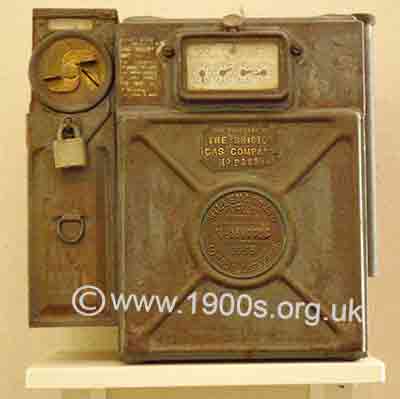Gas fires, mid-20th Century UK
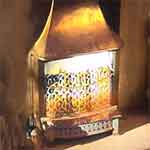
Gas fires heated by burning coal gas which had to be piped into rooms that were using them. This page explains the care that needed when turning on the gas, why the gas was dangerous; how the gas fires produced radiant heat and why they were not for everyday use. The viewpoint is that of users when central heating was unknown in ordinary houses, and the page is well-illustrated. Shilling gas meters are also considered.
____
By the webmaster: her early recollections with further research and discussions with others who lived at the time
Where gas fires were located in mid 20th century ordinary houses
Gas fires were the only heating I ever knew in bedrooms in the mid-20th century. The third bedroom, the hall, landing and lavatory had no form of heating at all, but the bathroom benefited from the warmth of the hot tank in the airing cupboard and being above the boiler in the kitchen. The sitting room and dining room had grates for coal fires - but coal fires were only lit when my father was at home. Fortunately the kitchen with its boiler was always warm.
Only the newer houses had the gas fires in bedrooms because the gas supply had to be 'plumbed in'. I grew up in a house that had been built about 1937, just before World War Two, and it had gas fires in two of the bedrooms, which was considered the height of luxury - not that my family would afford to light them other than in an emergency of some sort. The gas was of course coal gas, not the natural gas of today.
How gas fires were lit
Gas fires had to be lit carefully. We had to turn on the gas tap alongside the fire, wait a moment for the gas to come through and then light it with a match or taper. If the gas was left too long before lighting, it made a rather frightening bang which could singe or burn. If it wasn't lit at all, it would be dangerous because the gas, at that time, being coal gas, was poisonous.
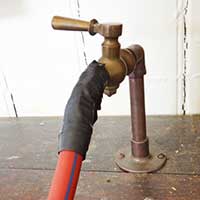
Typical brass gas tap in the 1940s and 50s. This one was photographed in Tilford Rural Life Museum where it was attached to a portable Bunsen Burner - hence the rubber tubing rather than the inflexible metal which would have been used for gas fires. In practice, never, never, never would any gas connections be made with sticky tape.
Gas taps for fires were located in floors next to the fires, and it was all too easy to trip over them. Also it was annoying to clean floors or carpets round them.
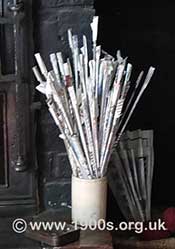
Spills for fire lighting at a distance waxed at the tips
How gas fires heated
Gas fires worked by heating the white ceramic open-patterned pillars shown in the photo. These were known as elements and they became red hot in the flames and radiated heat out into the rooms.
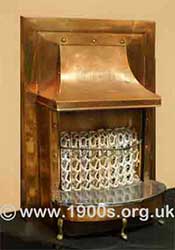
A domestic gas fire. This fire in Milestones Museum, Basingstoke, was not piped into a chimney, as it would have been in its original use - albeit that the chimney could have been hidden in the wall. With its brass surround, this gas fire is more elegant than the gas fires in my home which had a cream Bakelite surround.
Over time, elements became known as radiants. They were extremely brittle and could be damaged just by poking with a finger. They could be replaced from hardware shops, but invariably the patterns and heights were different. It was common to see such gas fires with one or more non-matching elements.
When ordinary families used gas fires
It was rare for us ordinary folk to use the gas fires. In very cold weather my mother lit them shortly before bedtime, but heating was considered extravagent, and they were never given time to heat the room properly. Anyway, the gas pressure was often too low to do much good, because of the austerity of the war years and their aftermath. I have clear memories of ice on the inside of my bedroom windows. (Incidentally the gas was never cut off like electricity in a power cut, because when it came on again with no-one knowing to light it, it would kill those who breathed it.)
Even in the late 1950s when I was at university, living in a hall of residence that was a renovated old house with gas fires, it was against the rules to have the gas fires on before 2.00pm. There was no other form of heating; it was very cold in winter, but we survived. We were young.
Like coal fires and paraffin heaters, gas fires used up the oxygen in the air to burn which made people feel drowsy.
Shilling - or pennies - in the slot gas meters and safety
Fortunately for my family at home and for us in halls of residence, the gas was on tap, ie we only had to turn on the tap for the gas to come through. Friends in lodgings had a gas meter, which needed to be fed with shillings.
A 'shilling in the slot' gas meter. The coins went in one of the slots on the left-hand-side and the dials showed how much gas was left to use. Photographed in Blaise Castle Museum.
It is a measure of inflation that in previous years, the earliest meters took pennies rather than shillings.
These early meters could be dangerous because when the gas ran out the fire went out. If later, someone put another shilling in the meter, the gas started flowing again, and being poisonous, it could kill. Later gas fires had a safety device which cut off gas if the ceramic elements were not being heated.
For householders, these meters were replaced with a quarterly bill in the early 1950s, but in rented accommodation they did continue into the 1980s or later as 50p in the slot meters.
Concluding remarks
Having lived through the 1940s and 50s, I can confirm that there was no really satisfactory way of heating other than central heaing which was only available in up-to-date public buildings like libraries, offices and schools. I was always either too cold or too hot on one side and cold on the other at home in winter.
| sources | webmaster | contact |
Text and images are copyright
If you can add anything to this page or provide a photo, please contact me.


